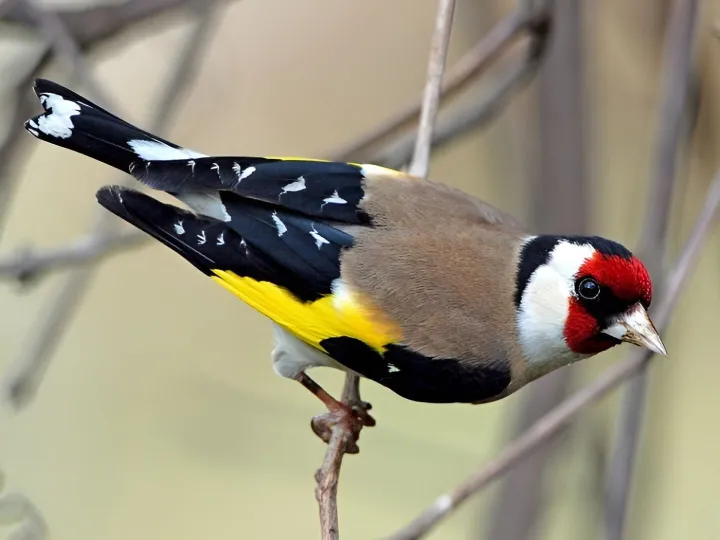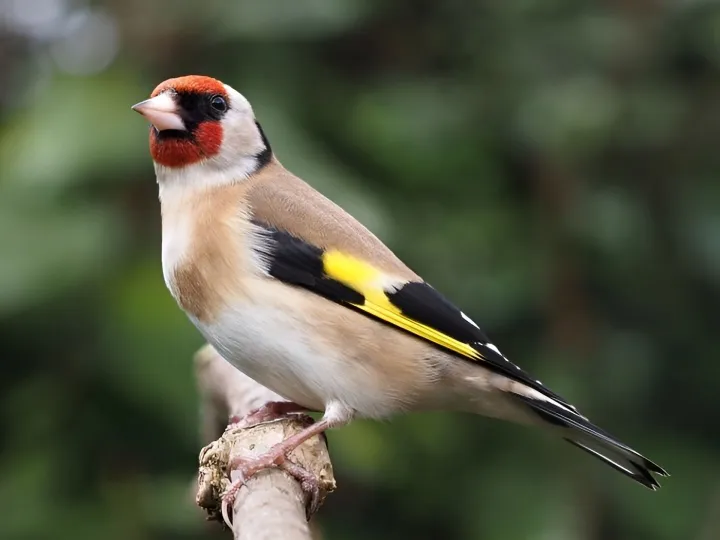Colour always catches the eye, and the Goldfinch, with its red face, black and white head, and black and bright yellow wings, is instantly recognisable when seen. As well as being present in the woodland, they are regular visitors to our bird feeders, devouring the sunflower hearts or nyger seeds and providing a welcome flash of colour to enliven a view populated by our resident squadrons of house sparrows. They seem to arrive in small flocks and use the nearby shrubs in which to hide and await a time when the feeders are less crowded and more peaceful.
Goldfinches are a relatively new arrival in this area. The population has spread northwards within Britain, and the birds are now found everywhere except on open mountains and moorland (they prefer low ground). Their song is a pleasant silvery twittering. The call is a melodic "tickeLIT", and the song is a tinkling medley of trills and twitters, always including the tri-syllabic call phrase or a "teLLIT-teLLIT-teLLIT". It is because of their attractive feathers and pleasing song that they were widely persecuted until the 1930s. During the 19th century, many thousands of Goldfinches were trapped each year in Great Britain to be sold as cage birds. This almost certainly kept the population below what it might have been, and one of the earliest campaigns by the Royal Society for the Protection of Birds was directed against this trade.
The Goldfinch's long, fine beak allows it to extract otherwise inaccessible seeds from thistles and teasels, and it is thought that their distribution reflects the distribution of their favoured food species, since they enjoy feeding on seeds of the family Compositae (the groundsels, ragworts, dandelions, and thistles).
Goldfinches nest in areas with scattered trees and shrubs (including gardens), where they often adopt the loose colony structure of a small flock. The nest is built entirely by the female and is generally completed within a week (the male accompanies the female but does not contribute to the work!). It is neatly woven from grasses, moss, roots, and lichens, interwoven with wool, hair, and plant down (such as that from thistles) and is usually positioned several metres off the ground, hidden by leaves in the twigs at the end of a swaying branch. It is attached to the twigs of the tree with spider silk, and a deep cup prevents the loss of eggs in windy weather. Egg-laying begins a couple of days after the nest is finished, and proceeds with one egg being laid each morning until the clutch of 4-6 eggs is complete. During the incubation period of approximately 12 days, the female is fed by the male, and once hatched, the young are brooded by the female for a further week. While very young, the diet of seeds is supplemented with insects, but as they grow older, the nestlings eat entirely seeds. The babies fledge between 2-3 weeks after hatching, with both parents continuing to feed them for another week or so. These same parents will probably go on to have yet another brood (or perhaps even two!) during the summer.
Adults moult after the breeding season, with some individuals beginning in July and others not completing their moult until November. After the moult, birds appear less colourful until the tips of their newly grown feathers wear away.
Some of our British Goldfinches will migrate as far south as Spain to avoid the worst of the harsh winter weather. Fortunately for us, many of these lovely little birds do remain and roam about in flocks of up to 100, searching for food. The teasels left standing in the woodland have proved to be a favourite with them, and some thistles are allowed to remain up at Austins Hill for the same reason.

